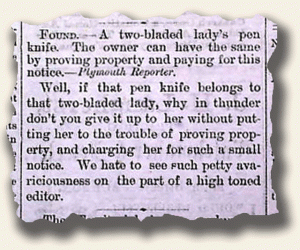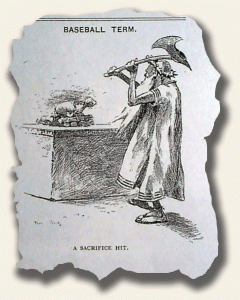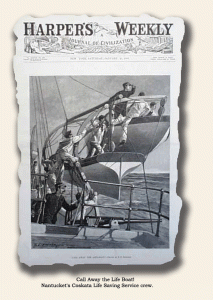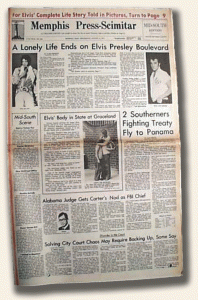Rare newspaper prices from 60 years ago…
July 30, 2009 by TimHughes · 2 Comments
 While cleaning out some files at home I came across a little catalog of “American Newspapers 1732 – 1890” offered for sale by Stephen Nagy of Philadelphia. The back page has various items noting the date of the catalog as 1948.
While cleaning out some files at home I came across a little catalog of “American Newspapers 1732 – 1890” offered for sale by Stephen Nagy of Philadelphia. The back page has various items noting the date of the catalog as 1948.
 The photos show some interesting prices. Some may not be shown in the photos but I noticed a Confederate issue of the “Norfolk Bulletin” of 1864 for $1.25; the “Daily Hawaiian Herald” of 1866 for $3; a colonial issue of the “Pennsylvania Chronicle” of Phila., 1768 for $7.50; a ‘Phila. Inquirer” with a first report of Lincoln’s assassination for $3; the very desirable “Inquirer” of April 25, 1865 with the full pg. illustration of Lincoln’s remains in Independence Hall for $4; and a wide selection of “Dunlap’s American Daily Advertiser“, Phila., from 1796 and 1797 for $1 each.
The photos show some interesting prices. Some may not be shown in the photos but I noticed a Confederate issue of the “Norfolk Bulletin” of 1864 for $1.25; the “Daily Hawaiian Herald” of 1866 for $3; a colonial issue of the “Pennsylvania Chronicle” of Phila., 1768 for $7.50; a ‘Phila. Inquirer” with a first report of Lincoln’s assassination for $3; the very desirable “Inquirer” of April 25, 1865 with the full pg. illustration of Lincoln’s remains in Independence Hall for $4; and a wide selection of “Dunlap’s American Daily Advertiser“, Phila., from 1796 and 1797 for $1 each.
We’ve never promoted the investment potential of rare newspapers but rather encourage the collecting of historic issues for enjoyment & personal pleasure, but this catalog from the past does give evidence of the considerable variance in prices from 61 years ago. Additional images of this early newspapers catalog may be found at: American Newspapers (1732-1890) Catalog – 1948.
Newspaper circulation in the 1700’s…
July 27, 2009 by TimHughes · 1 Comment
 We often get queries as to what the circulation numbers were of colonial and later 18th century newspapers. Clarence Brigham, in his book “Journals & Journeymen” provides some helpful information.
We often get queries as to what the circulation numbers were of colonial and later 18th century newspapers. Clarence Brigham, in his book “Journals & Journeymen” provides some helpful information.
The earliest comment on newspaper circulation in America was by publisher John Campbell in his Boston News-Letter of 1719. He notes that “…he cannot vend 300 at an impression, tho’ some ignorantly concludes he sells upwards of a thousand…”.
Famed publisher Isaiah Thomas remarked: “In 1754 four newspapers only were printed in New England…weekly, & the average number of copies did not exceed 600 from each press.”
Circulation gradually grew as the days of the Revolution approached. Rivington’s New York Gazetteer of Oct. 31, 1774 boated his weekly impressions “… increased to 3600…”, and Thomas noted in his Mass. Spy of Dec. 21, 1780 noted he had a pre-Revolutionary circulation of 3500 copies, then was driven out of Boston by the British invasion & established the Spy in Worcester. In 1775-6 circulation was 1500, in 1778-9 it was 1200, and in 1781 it did 500 impressions. He also noted that: “It has always been allowed that 600 customers, with a considerable number of advertisements, weekly, will but barely support the publication of a newspaper.”
Later Thomas noted that the famous Connecticut Courant of Hartford had a circulation which exceeded his Mass. Spy, that: “…the number of copies printed weekly was equal to, if not greater, than that of any other paper on the continent.”
In the last decade of the 18th century the number of newspapers increated, but circulation did not keep step & in generally averaged from 600 to 700. A few papers from larger cities were exceptions such as the Maryland Journal of Baltimore which claimed a circulation of near 2000. And the very popular Columbian Centinel would top the list of all 18th century newspapers in circulation with over 4000 per issue. Other popular late-18th century titles & their circulations included the Aurora with 1700; the Farmer’s Weekly Museum with 2000 and Porcupine’s Gazette with over 2000 in circulation in 1799.
But given these numbers, how many copies of any single date survived? A good question as certainly the vast majority were read and discarded. Outside of those held by institutions in bound volumes those which exist in collectors’ hands today almost assuredly came from deccessioned institutional holdings and likely will be the only issues to see the light of day for many years to come.
Competition isn’t always friendly…
July 25, 2009 by TimHughes · Leave a Comment
 The “Amador Dispatch” newspaper from Jackson, California—small mining town in the northern part of the state—has two related items in its April 8, 1882 issue. The first is a report from the neighboring “Plymouth Reporter” newspaper concerning a pen knife which was found noting the owner could have it by proving ownership & by paying for the newspaper notice. The other is an editorial note from the competing “Dispatch” which includes: “…why in thunder don’t you give it up to her without putting her to the trouble of proving property, and charging her for such a small notice. We hate to see such petty avariciousness on the part of a high toned editor.”
The “Amador Dispatch” newspaper from Jackson, California—small mining town in the northern part of the state—has two related items in its April 8, 1882 issue. The first is a report from the neighboring “Plymouth Reporter” newspaper concerning a pen knife which was found noting the owner could have it by proving ownership & by paying for the newspaper notice. The other is an editorial note from the competing “Dispatch” which includes: “…why in thunder don’t you give it up to her without putting her to the trouble of proving property, and charging her for such a small notice. We hate to see such petty avariciousness on the part of a high toned editor.”
I guess competing newspapers were not always friendly towards one another.
My Collecting Story… Gregory Christiano…
July 23, 2009 by GuyHeilenman · Leave a Comment
 Many people think of a newspaper as ephemera, something to be thrown away after you read it or to be used to wrap fish or make silly hats. I never looked at it that way. After college graduation in 1969 I began to get an interest in antiquarian books, maps, prints and other collectibles. It wasn’t until I saw an ad in the paper for historic and antique newspapers. I sent away for the catalogue and notice a reference to a baseball game with line and box scores in a New York paper from 1865. I was curious and spent $2.00 to purchase it. Well, that got me hooked. Being an avid baseball fan, I lost all control and purchased dozens of those early papers with accounts of baseball games. In those early days (1970’s) it was relatively inexpensive to buy 19th century newspapers. There were only a few dealers and I became a regular customer. Timothy Hughes was one of my very first suppliers. I was never disappointed with the condition and the authenticity of my purchases.
Many people think of a newspaper as ephemera, something to be thrown away after you read it or to be used to wrap fish or make silly hats. I never looked at it that way. After college graduation in 1969 I began to get an interest in antiquarian books, maps, prints and other collectibles. It wasn’t until I saw an ad in the paper for historic and antique newspapers. I sent away for the catalogue and notice a reference to a baseball game with line and box scores in a New York paper from 1865. I was curious and spent $2.00 to purchase it. Well, that got me hooked. Being an avid baseball fan, I lost all control and purchased dozens of those early papers with accounts of baseball games. In those early days (1970’s) it was relatively inexpensive to buy 19th century newspapers. There were only a few dealers and I became a regular customer. Timothy Hughes was one of my very first suppliers. I was never disappointed with the condition and the authenticity of my purchases.
When I first started collecting these papers, I had to learn about their fragility the hard way. I try to keep my collection pre-1870’s because those newspapers were printed on rag cloth and can be preserved a very long time. The technology to print newspapers on pulp had been around since the mid-nineteenth century but really picked up by the later`part of the 1870’s. My collection includes late 19th-century and twentieth century issues. Most of them are crumbling to the touch because of the sawdust-composite nature of newsprint. My bound volume of the NY Herald from 1877 is turning to dust. I do have a unique bound volume of the New York Times from early 1940’s printed on silk for archive storage. I picked that up at an auction in the early 1980s. To this day it looks brand new! My 20th-century collection is becoming brittle with each day, even after taking precautions to preserve these cherished papers. They are discolored and disintegrating. That’s why libraries have placed all their collections on microfiche.
I just don’t have the discretionary cash to have a professional paper conservator preserve my entire collection. I use the standard acid-free buffered boxes and folders (careful to keep the newspaper unfolded), storing my collection in a dark environment with a stable temperature between 65 and 70 degrees.
Most of my collection consists of mostly 19-century New York City papers – Sunday Mercury, Herald, Tribune, World, Sun, Times, Daily Star, Daily Graphic, then into the twentieth-century with Herald-Tribune, World, Telegram and Sun, Journal American, Mirror, Daily News. Then I branched out to Colonial and Revolutionary period, with titles like Dunlap and Claypool American Daily Advertiser (1790s – I have about four issues), The Aurora (Benjamin Franklin Bache – 1790s), Pennsylvania Packet and Daily Advertiser from 1793 [the forerunner to Dunlap’s paper].
I also have some sporting magazines, Porter’s Spirit of the Times, Wilke’s Spirit of the Times, and of course, Harper’s Weekly and others. Today I concentrate on specific issues of interest for me, like early reporting on rapid transit in New York City [the New York Daily Graphic has some terrific illustrations of the early elevated lines, like the Gilbert Elevated RR, sporting events, Civil War accounts etc.
Some rare titles: Day’s New-York Bank Note List, Counterfeit Detector and Price Current. published 1826-1859 [I collect bank notes and coins also]… Demorest’s New York Illustrated News…a couple of 1864 copies. Greenleaf’s New-York Journal & Patriotic Register (late 1790s) – I have a couple of these. On and on and on. They are too numerous to list here. I’ve been collecting for over 30 years, and am still fascinated with every issue I have in my collection.
I am on mailing lists and receive constant updates on what is available. The prices have gone up, but still reasonable. What copies I can’t obtain, I can see at the New York Public Library where I go to access their microfilm department to read and photocopy some of the rarer issues. There is nothing like reading history as it happened, by eyewitnesses as the events unfolded. With the future of newspapers in question, collecting them is even more important. Yesterday’s newspapers are not dead, not irrelevant, but still alive:
This is what really happened, reported by a free press to a free people. It is the raw material of history; it is the story of our own times. -Henry Steel Commager, preface to a history of the New York Times, 1951
– – – – – – – – – – – – – – – – – – – – – – – – – – – – – – – – – – – – – – – – – –
Thanks for sharing your story Gregory. If you would like to share your story of how you became interested in collecting rare and/or historic newspapers, e-mail it to guy@rarenewspapers.com and place “My Story” in the subject field. Although not necessary, feel free to include an image. Please do not include your e-mail address or a personal website as part of the text of your story. We will post collector stories every few weeks and will send you a notice when your story appears. Thank you for your contribution to the community.
“Telegraph” newspapers prior to 1844?
July 20, 2009 by TimHughes · Leave a Comment
 It is commonly known that the magnetic telegraph was developed in 1844 by Samuel Morse, so perhaps you’ve wondered—like I have—why so many newspapers had the title “Telegraph” dating long before this date? Clarence Brigham in his book “Journals & Journeymen” provides some details.
It is commonly known that the magnetic telegraph was developed in 1844 by Samuel Morse, so perhaps you’ve wondered—like I have—why so many newspapers had the title “Telegraph” dating long before this date? Clarence Brigham in his book “Journals & Journeymen” provides some details.
Between 1792 & 1794 several systems of telegraphic signals were developed in England & France. They were dependent upon cross-bars pivoting into difference positions at the top of high poles.
In 1795 a paper was established at Carlisle, Pennsylvania, titled “The Telegraphe”. The first issue did a history of telegraphic experiments taken from British & French periodicals, & stated it was the first paper in America to use the title. This was true, but less than a month after the Carlisle paper’s beginning the “Fells Point Telegraphe” was established at Baltimore, and shortly thereafter newspapers in Charleston, Greenfield (Mass.), and again in Baltimore changed their titles to include the word “Telegraphe”. In the next five months another 4 newspapers incorporated this word into their titles.
By 1820 forty newspapers in America had employed this word into their mastheads, but the phenomena was almost entirely American. Curiously only 2 papers in London & Paris used the word in 1794 and none after that until later in the 19th century.
A new (old) definition of a “sacrifice hit”…
July 18, 2009 by TimHughes · Leave a Comment
 Since we are in the midst of baseball season, this little comic item from “Life” magazine of June 28, 1894 would seem appropriate.
Since we are in the midst of baseball season, this little comic item from “Life” magazine of June 28, 1894 would seem appropriate.
A time to have fun and to gather perspective…
July 16, 2009 by GuyHeilenman · Leave a Comment
Earlier this week Timothy Hughes Rare & Early Newspapers sent a newsletter to their members which contained a fun contest and a little food for thought. Based on member feedback, we thought the History’s Newsstand subscribers might also enjoy the newsletter (especially items 1, 2, and 6).
Newsletter (sent to members on July 14, 2009)
Dear Friends of Rare Newspapers,
Welcome to the July 2009 edition of our monthly newsletter. In an effort to counter (or at least soften) the pervasively negative economic/political tone which seems to be swirling about from every direction, we’d like to offer a few diversions (see items 1, 2, and 6 below). Please enjoy!
1. A New Scavenger Hunt – The History’s Newsstand Blog exists to serve those interested in the rare newspapers collectible. For the next 7 days we would like to encourage our members to go “scavenger hunting” at the blog. We’ve placed an image (see below) at the bottom of one of the posted articles which includes a discount code below the image (as a caption). This code may be entered at checkout at www.rarenewspapers.com to receive 20% off any website order, no matter how large or small. The code, if found, may be shared with friends, but it may only be used toward website listings (not eBay or custom quotes), and it may not be used in conjunction with any other discount code (new customer, new member, premium member, etc.). Have fun! Read the articles. Enjoy!!! The image to be “unearthed” is:
(the contest image looks identical to the above image)
2. Blog Posts from History’s Newsstand with a humorous edge may be accessed at: http://blog.rarenewspapers.com/?cat=116
3. The Most Recent Offering – Catalog 164 (just released) – Over 300 newly listed hand-picked issues may be viewed/purchased at: http://www.rarenewspapers.com/list?code=supplement
4. Discounted Items – From now until July 31st, we have a selection of issues which have been discounted by 20% (price shown reflects the discount). The “theme” of these items is 20th century “Displayable” issues. They may be viewed at: http://www.rarenewspapers.com/list?code=Discounted+Issues
5. Timely eBay/website listings:
Moon Landing (on eBay)
Stock Market Crash (on the website)
Abraham Lincoln (on eBay)
Public Enemies, Gangsters, etc. (on the website)
6. Food for Thought – Concerning Our Current Economic and Political Environment (source: wikipedia):
“This too shall pass” (Hebrew: גם זה יעבור, gam zeh yaavor) is a phrase occurring in a Jewish wisdom folktale involving King Solomon. The phrase is commonly engraved on silver rings.
Many versions of the folktale have been recorded by the Israel Folklore Archive at the University of Haifa. Heda Jason recorded this version told by David Franko from Turkey:
“One day Solomon decided to humble Benaiah Ben Yehoyada, his most trusted minister. He said to him, “Benaiah, there is a certain ring that I want you to bring to me. I wish to wear it for Sukkot which gives you six months to find it.” “If it exists anywhere on earth, your majesty,” replied Benaiah, “I will find it and bring it to you, but what makes the ring so special?” “It has magic powers,” answered the king. “If a happy man looks at it, he becomes sad, and if a sad man looks at it, he becomes happy.” Solomon knew that no such ring existed in the world, but he wished to give his minister a little taste of humility. Spring passed and then summer, and still Benaiah had no idea where he could find the ring. On the night before Sukkot, he decided to take a walk in one of the poorest quarters of Jerusalem. He passed by a merchant who had begun to set out the day’s wares on a shabby carpet. “Have you by any chance heard of a magic ring that makes the happy wearer forget his joy and the broken-hearted wearer forget his sorrows?” asked Benaiah. He watched the grandfather take a plain gold ring from his carpet and engrave something on it. When Benaiah read the words on the ring, his face broke out in a wide smile. That night the entire city welcomed in the holiday of Sukkot with great festivity. “Well, my friend,” said Solomon, “have you found what I sent you after?” All the ministers laughed and Solomon himself smiled. To everyone’s surprise, Benaiah held up a small gold ring and declared, “Here it is, your majesty!” As soon as Solomon read the inscription, the smile vanished from his face. The jeweler had written three Hebrew letters on the gold band: gimel, zayin, yud, which began the words “Gam zeh ya’avor” — “This too shall pass.” At that moment Solomon realized that all his wisdom and fabulous wealth and tremendo us power were but fleeting things, for one day he would be nothing but dust.”
The phrase “This too shall pass” and the associated ring story were made popular by Abraham Lincoln in his ‘Address Before the Wisconsin State Agricultural Society, Milwaukee, Wisconsin’ on September 30, 1859.
“It is said an Eastern monarch once charged his wise men to invent him a sentence, to be ever in view, and which should be true and appropriate in all times and situations. They presented him the words: “And this, too, shall pass away.” How much it expresses! How chastening in the hour of pride! How consoling in the depths of affliction!
Best wishes,
Guy & The Rare Newspapers Staff
If you’d like to become a member of “Rare Newspapers” (free), you’re invited to sign-up at: http://www.rarenewspapers.com/memberships
Quotes defining history…
July 13, 2009 by Morris Brill · 2 Comments
When I was fourteen years old (ah, so many years ago) I acquired an interest in quotations. By the time I was twenty-one I had read the entire collection of Bartlett’s Famous Quotations and recorded each of the quotes that had significance for me. I have since added to my list of favorites.
Coincidentally, when I was twenty-one, I also bought my first collectable newspaper; The Assassination of President John F. Kennedy.
Many years ago I concluded that often a quote, paired with a specific headline, added profound meaning to the headline. The right quotation enhanced the moral or social significance of the headline. Often, the right quote was able to capture the ‘essence’ of the headline.
Quotes, like newspapers, unite us with the past. They provide us with the thoughts of those who came before us. Additionally, within a newspaper, you may find text that contains a statement that later becomes a famous quote.
For instance: the Boston Gazette of December 26, 1805 contains a report on the Battle of Trafalgar. The article quotes British Admiral Horatio Nelson as saying, “England expects that every man will do his duty.” And we all know of President Franklin Roosevelt’s quote in his inaugural acceptance speech in 1933, “There is nothing to fear but fear itself,” which can be found on the front page of many newspapers of the time.
Of course, each individual would select different quotes to pair with a headline. I believe that the quotes a person prefers are a reflection of that person’s personal social background, religious background, education, and political persuasion.
With that said, and with your indulgence, I would like to share with you a very small sample of my pairings.
Headline: Treaty of Peace – Pennsylvania Packet – 11/08/1783
Quote: “What a free society offers to the individual is much more than what he would be able to do if only he were free.” – F.S. Hayek
Headline: Death of Benjamin Franklin – The Gentleman’s Magazine – 06/01/1790
Quote: “It is sweet to serve one’s country by deeds, and it is not absurd to serve her by words” – Sallust
Headline: Death of President Washington – The True American – 01/01/1800
Quote: “A patriot must always be ready to defend his country against his government” – Edward Abbey
Headline: Queen Victoria Coronation – Main Farmer/Journal of Useful Arts – 08/07/1838
Quote: “Uneasy is the head that wears a crown” – William Shakespeare
Headline: This “Flying Machine” Flies – Philadelphia Press – 12/19/1903
Quote: “I think for months and years. Ninety-nine times, the conclusion is false. The hundredth time I am right” – Albert Einstein
Headline: Life Terms in Prison for Leopold and Lobe – Los Angeles Evening Herald – 02/04/1924
Quote: “Being brilliant is no great feat if you respect nothing” – Johann Wolfgang von Goethe
Headline: Death Takes Stalin’s Reign – Syracuse Herald-Journal – 06/06/1954
Quote: “O, it is excellent to have a giant’s strength! But it is tyrannous to use it like a giant.” – William Shakespeare
Headline: Eichmann Convicted – Los Angeles Mirror – 12/11/1961
Quote: “The belief in a supernatural source of evil is not necessary; men alone are quite capable of every wickedness.” – Joseph Conrad
Headline: A Lonely Life Ends on Elvis Presley Boulevard – Memphis Press Scimtar – 08/17/1977
Quote: “It is loneliness that makes the loudest noise. This is true of men as of dogs.” – Eric Hoffer
Thank you for attention and interest.
Morris Brill
Darwin’s “other” sons…
July 11, 2009 by TimHughes · Leave a Comment
 The Ogden Junction newspaper from Utah, dated September 6, 1873, includes this small comic tidbit making light of Darwin’s theory of evolution.
The Ogden Junction newspaper from Utah, dated September 6, 1873, includes this small comic tidbit making light of Darwin’s theory of evolution.
My Collecting Story… Brendan Dwyer…
July 9, 2009 by GuyHeilenman · Leave a Comment
Here is my antique newspaper collecting story. Not how I got started, but in the middle:
 —–I moved to Nantucket [see 19th century image] in 1997 and fell in love with it’s rich history—-whaling, Quakers, isolation, American Revolution neutralism, etc.—Well–in 1795 a bank robbery occurred here where around $20,000 was taken in various international currency ( keep in mind the date and the world travels of the whaling industry). This robbery shocked and shucked the town whereby feuds developed and lasted for generations. All very interesting. Well, I found out the court dates of the accused robbers and the newspapers which covered the proceedings. I had been buying antique newspapers from [Timothy Hughes Rare & Early Newspapers] for a number of years, so I searched [the] site and found several of the newspapers which covered the court proceedings.
—–I moved to Nantucket [see 19th century image] in 1997 and fell in love with it’s rich history—-whaling, Quakers, isolation, American Revolution neutralism, etc.—Well–in 1795 a bank robbery occurred here where around $20,000 was taken in various international currency ( keep in mind the date and the world travels of the whaling industry). This robbery shocked and shucked the town whereby feuds developed and lasted for generations. All very interesting. Well, I found out the court dates of the accused robbers and the newspapers which covered the proceedings. I had been buying antique newspapers from [Timothy Hughes Rare & Early Newspapers] for a number of years, so I searched [the] site and found several of the newspapers which covered the court proceedings.
Keep in mind this was from 1795!!!!! Just amazing!!!!!!!!!!!!!!!!!!!
– – – – – – – – – – – – – – – – – – – – – – – – – – – – – – – – – – – – – – – – – –
Thanks for sharing your story Brendan. If you would like to share your story of how you became interested in collecting rare and/or historic newspapers, e-mail it to guy@rarenewspapers.com and place “My Story” in the subject field. Although not necessary, feel free to include an image. Please do not include your e-mail address or a personal website as part of the text of your story. We will post collector stories every few weeks and will send you a notice when your story appears. Thank you for your contribution to the community.




